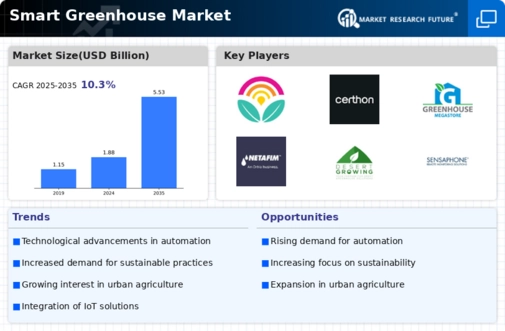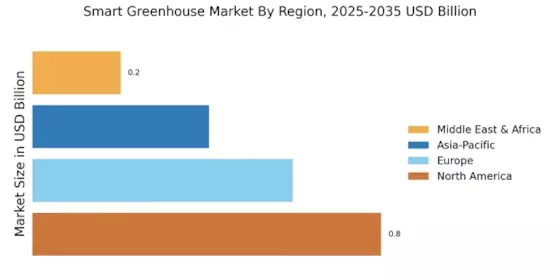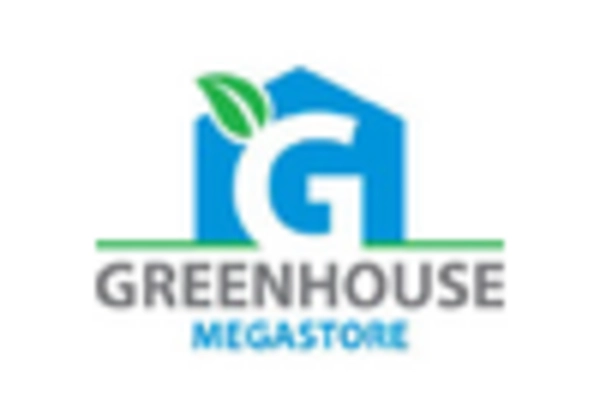Rising Demand for Organic Produce
Consumer preferences are shifting towards organic produce, significantly impacting the Smart Greenhouse Market. As health-conscious consumers increasingly seek fresh, pesticide-free fruits and vegetables, smart greenhouses offer a viable solution to meet this demand. These facilities can provide controlled environments that enhance the growth of organic crops while minimizing the use of harmful chemicals. Market data suggests that the organic food sector is projected to grow at a compound annual growth rate of over 10% in the coming years. This trend is likely to encourage more farmers to adopt smart greenhouse technologies, as they align with sustainable practices and consumer expectations. Consequently, the Smart Greenhouse Market is poised to benefit from this growing inclination towards organic farming, potentially leading to increased investments and innovations in greenhouse technologies.
Government Initiatives and Support
Government initiatives aimed at promoting sustainable agriculture are playing a crucial role in the Smart Greenhouse Market. Various countries are implementing policies that encourage the adoption of smart farming technologies, including financial incentives, grants, and subsidies for greenhouse construction and operation. These initiatives are designed to enhance food security, reduce environmental impact, and promote efficient resource use. For instance, some governments have set ambitious targets for reducing greenhouse gas emissions from agriculture, which can be achieved through the implementation of smart greenhouse technologies. As a result, the Smart Greenhouse Market is likely to see increased participation from farmers and investors, driven by favorable regulatory environments and support mechanisms. This trend suggests a collaborative effort between the public and private sectors to advance agricultural sustainability.
Urbanization and Space Constraints
The increasing trend of urbanization is reshaping the Smart Greenhouse Market, as space constraints in urban areas drive the need for innovative agricultural solutions. With more people moving to cities, traditional farming practices are becoming less feasible, leading to a growing interest in urban agriculture. Smart greenhouses, which can be installed in limited spaces such as rooftops and vacant lots, offer a practical solution for urban dwellers seeking fresh produce. Market data indicates that urban agriculture is expected to grow significantly, with smart greenhouses playing a pivotal role in this transformation. By utilizing advanced technologies to maximize space and resources, these greenhouses can contribute to local food production and reduce transportation emissions. This trend highlights the potential for the Smart Greenhouse Market to thrive in urban settings, catering to the needs of city populations.
Climate Change and Environmental Concerns
The growing awareness of climate change and its impact on agriculture is significantly influencing the Smart Greenhouse Market. As extreme weather events become more frequent, traditional farming methods face challenges that threaten crop yields and food security. Smart greenhouses, equipped with climate control technologies, can mitigate these risks by providing stable growing conditions regardless of external weather fluctuations. Market analysis indicates that the demand for climate-resilient agricultural solutions is on the rise, with smart greenhouses emerging as a key player in this sector. By enabling year-round production and reducing dependency on unpredictable weather patterns, these facilities are likely to attract more farmers seeking reliable and sustainable farming methods. This trend underscores the importance of innovation in addressing environmental challenges within the Smart Greenhouse Market.
Technological Advancements in Agriculture
The Smart Greenhouse Market is experiencing a surge due to rapid technological advancements in agricultural practices. Innovations such as automated climate control systems, advanced irrigation techniques, and real-time monitoring tools are becoming increasingly prevalent. These technologies enhance crop yield and reduce resource consumption, making greenhouses more efficient. According to recent data, the integration of smart technologies can increase productivity by up to 30%. As farmers seek to optimize their operations, the demand for smart greenhouses is likely to rise, driving market growth. Furthermore, the ability to remotely manage greenhouse conditions through mobile applications adds convenience, appealing to a broader range of agricultural stakeholders. This trend indicates a shift towards more tech-savvy farming methods, positioning the Smart Greenhouse Market for substantial expansion.


















Leave a Comment